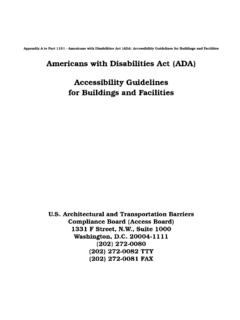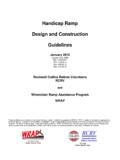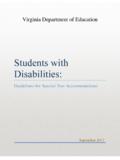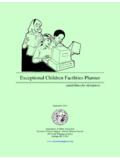Transcription of TRANSPORT STRATEGY TO IMPROVE ACCESSIBILITY IN DEVELOPING ...
1 TRANSPORT STRATEGY TO IMPROVE ACCESSIBILITY IN DEVELOPING countries Peter Roberts, Lead Specialist for Infrastructure Services, Julie Babinard, Consultant The World Bank SUMMARY In DEVELOPING countries disabled people and the elderly are more likely to be among the poor. Moreover, exclusion increases the costs associated with disability to constrain disabled people from breaking out of poverty. Improved access and mobility are important factors in reducing poverty and can facilitate the participation of people with disabilities in economic, social and political processes. Many countries have legislation requiring that these challenges be addressed but effective responses are generally very limited. Action to IMPROVE the situation is constrained by the serious shortage of data on the access and mobility needs of disabled and elderly people as well as by resource constraints.
2 This paper outlines guidance for addressing the access and mobility needs of disabled and elderly people in the context of the World Bank s mission to reduce poverty and discusses the main challenges for providing inclusive TRANSPORT . It draws attention to opportunities to learn from TRANSPORT interventions and to current research. The paper describes the main activities being fostered by the TRANSPORT Sector in the World Bank. These aim to raise awareness of proven good practice in setting policies and strategies. We also contribute to a community of practice which draws on current and new experience to IMPROVE planning, design and implementation for inclusive TRANSPORT in DEVELOPING countries . DISABILITY, POVERTY AND TRANSPORT The United Nations estimates that between 6 and 10% of the population in DEVELOPING countries has a disability some 400 million people world wide.
3 The challenges faced by these people vary considerably but the shortage of reliable data makes it difficult to form a useful picture of the scale and nature of their needs. Indications are that, generally in low-income countries , 40 to 50% of all disabled people have sensory disabilities (including blindness, low vision, deafness, poor hearing and impaired speech); while 20 to 50% people have various physical disabilities, and in the order of 7 to 15% have cognitive disabilities (Venter et al., 2002). In low-income countries disabled people are more likely to be poor than is the rest of the population. Case studies in a number of countries show that higher disability rates are associated with higher illiteracy, poor nutritional status, lower inoculation and immunization coverage, higher unemployment rates, and lower occupational mobility, among other characteristics (Elwan, 1999).
4 The livelihoods and economic opportunities of disabled people in DEVELOPING countries are often worse because they are more likely to be excluded from services, social contact and community activities. This exclusion in turn leads to reduced social, cultural, educational and economic opportunities; thereby increasing the risk that people with disability will further fall into poverty. Such exclusion also imposes direct costs on society by reducing the economic and social output, not only of those with disabilities but also of those who care for them and whose productive employment may be reduced as a result (Metts, 2000). Disabled and elderly people in low-income countries around the world have starkly emphasized the constraints which they suffer: "Disabled people are not seen as human beings; they are isolated at home and not sent to school" -- Kabale focus group, Uganda 1998.
5 The disabled remain isolated. Lack of special TRANSPORT confines them to a single neighborhood, special school, small church, local polyclinic, and small shop. -- Armenia 1995 These quotations are part of the extensive testimony given in Voices of the Poor a major international consultation carried out at the turn of the Millennium to inform the international development agenda (Narayan, 2000). Inclusive TRANSPORT systems are all the more critical in reducing the isolation, vulnerability and dependency of people with disability thereby helping to IMPROVE the lives of many of the world s poorest. However, the lack of basic data is a serious impediment to estimating the proper nature of demand for more inclusive TRANSPORT , so as to respond to the actual needs of all people whose access and mobility are severely constrained.
6 It also inhibits measurement of the impact of so doing (Rickert, 2001). CHALLENGES FOR INCLUSIVE TRANSPORT A study (Venter et al., 2003) funded by the United Kingdom Department for International Development (DFID) examined approaches to meeting access needs in several DEVELOPING countries in Africa, Asia and Latin America. Three main types of (interrelated) barrier for people with disabilities were identified: social (including high cost, lack of disability awareness, and communication difficulties); psychological (such as fear for personal safety); and structural (including infrastructure, operations and information). Globally there has been progress in reducing barriers in the TRANSPORT environment over the last four decades, particularly in the and some European countries in response to strong advocacy. Even in these high income countries implementation has spread slowly and the overall impact often remains disappointing.
7 The majority of low and middle-income countries now also have disability policies that reflect reasonably advanced concepts of disability, based on the UN 1982 World Program of Action Concerning Disabled Persons (WPA) and 1994 Standard Rules on the Equalization of Opportunities for Persons with Disabilities (Standard Rules) (Metts, 2000). However, the reality is that meeting the needs of people with disability is still largely seen as a welfare issue in most countries and even basic good practice in meeting those needs is rarely recognized, let alone implemented. As a result, inclusive TRANSPORT systems have generally not been given significant priority in planning, design and construction in DEVELOPING countries . Putting Policies into Practice Major obstacles remain to translate ACCESSIBILITY policies into the provision of inclusive TRANSPORT .
8 Inadequate monitoring and enforcement of compliance with existing ACCESSIBILITY legislation is widely cited as the key impediment to providing inclusive TRANSPORT in DEVELOPING countries . The legislation has rarely been matched by adequately detailed regulatory frameworks and has therefore generated a very limited response on the ground. For example, legislation in Mozambique, Malawi and India requires that there should be seats in urban public TRANSPORT and trains reserved for passengers with disabilities and that these passengers should be granted fare concessions of up to 100%. However, experience shows that only occasionally are these measures implemented or enforced (Maunder, 2004). Another important reason given for the lack of effectiveness of access policies and legislation is the lack of resources for implementation.
9 Governments often find it difficult to allocate funding for this in the face of pressure to meet other priorities. The private sector may not have sufficient incentives to implement provisions for people with disabilities. In most cases, applying Western disability standards and facilities to deliver access solutions and ensure universal access in TRANSPORT systems is not affordable or realistic for the provider or for the users in low-income countries -as most of them are too poor to pay the costs of such standards Making Implementation effective Lack of data makes it impossible to provide a meaningful overall cost estimate for the interventions required to meet the ACCESSIBILITY needs of disabled people in DEVELOPING countries . It is clear that the marginal costs of providing access for all features are generally much less when these are incorporated in the original design and build as compared with being retro-fitted to existing vehicles or infrastructure.
10 One suggested approach is that about one percent of the combined annual operating and capital costs of a typical TRANSPORT system would suffice to provide more accessible TRANSPORT , assuming that regulatory and enforcement mechanisms are in place (Meril inen and Helaakoski, 2001). However, poor countries face huge demands for their limited resources, both within TRANSPORT and in other priority sectors. Accordingly, the allocation of even rather modest portions of the budget must be justified in relation to alternatives ways of meeting the need under local circumstances, and in comparison with competing priorities for public resources. Mobility and access requirements of people with disabilities should be understood in the wider context when planning and designing barrier-free TRANSPORT systems. This implies an understanding and identification of the circumstances that create barriers for people with disabilities (Meril inen and Helaakoski, 2001).














